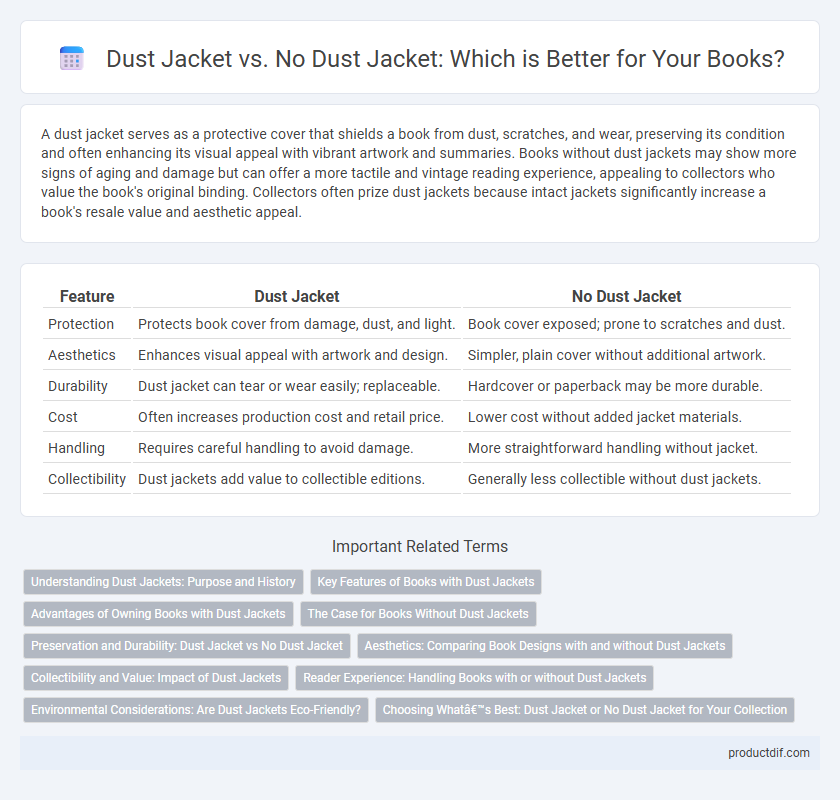A dust jacket serves as a protective cover that shields a book from dust, scratches, and wear, preserving its condition and often enhancing its visual appeal with vibrant artwork and summaries. Books without dust jackets may show more signs of aging and damage but can offer a more tactile and vintage reading experience, appealing to collectors who value the book's original binding. Collectors often prize dust jackets because intact jackets significantly increase a book's resale value and aesthetic appeal.
Table of Comparison
| Feature | Dust Jacket | No Dust Jacket |
|---|---|---|
| Protection | Protects book cover from damage, dust, and light. | Book cover exposed; prone to scratches and dust. |
| Aesthetics | Enhances visual appeal with artwork and design. | Simpler, plain cover without additional artwork. |
| Durability | Dust jacket can tear or wear easily; replaceable. | Hardcover or paperback may be more durable. |
| Cost | Often increases production cost and retail price. | Lower cost without added jacket materials. |
| Handling | Requires careful handling to avoid damage. | More straightforward handling without jacket. |
| Collectibility | Dust jackets add value to collectible editions. | Generally less collectible without dust jackets. |
Understanding Dust Jackets: Purpose and History
Dust jackets serve as protective covers for books, shielding their hardcovers from damage and wear while often featuring artwork and information to entice readers. Historically, dust jackets emerged in the early 19th century, evolving from simple protective wrappers to elaborate marketing tools that enhance a book's visual appeal. Collectors often value dust jackets highly, as their presence can significantly increase a book's rarity and monetary worth compared to identical editions without jackets.
Key Features of Books with Dust Jackets
Books with dust jackets feature a protective paper cover that shields the hardcover from damage, preserving the book's condition and value. The dust jacket often includes vibrant, eye-catching artwork and essential information such as the author biography, synopsis, and publisher details, enhancing shelf appeal. Dust jackets also provide added durability against dirt, moisture, and wear during handling and storage.
Advantages of Owning Books with Dust Jackets
Books with dust jackets offer superior protection against dust, moisture, and light damage, preserving the book's condition over time. The dust jacket serves as a decorative element, often featuring vibrant artwork, summaries, and author information that enhance the reading experience and collectible value. Collectors and bibliophiles frequently seek dust jackets for their role in maintaining a book's resale value and aesthetic appeal.
The Case for Books Without Dust Jackets
Books without dust jackets offer enhanced durability by eliminating fragile paper covers prone to tearing and wear, making them ideal for frequent handling. Hardcover bindings exposed provide a tactile experience and aesthetic appeal that integrates seamlessly into bookshelves, reducing the risk of damage during use. The absence of dust jackets also minimizes environmental waste from disposable packaging, aligning with sustainable reading practices.
Preservation and Durability: Dust Jacket vs No Dust Jacket
Dust jackets provide an essential protective layer that shields books from dust, moisture, and physical wear, significantly extending the lifespan of both hardcover and paperback editions. Without a dust jacket, book covers are more vulnerable to fading, scratches, and damage from handling, which can decrease their aesthetic and structural integrity over time. Collectors and librarians often prioritize books with intact dust jackets for preservation, as they maintain a book's condition and value far better than those without protective coverings.
Aesthetics: Comparing Book Designs with and without Dust Jackets
Books with dust jackets often feature vibrant, eye-catching cover art and protective coatings that enhance visual appeal while preserving the underlying book cover. Without dust jackets, book designs tend to emphasize the texture and craftsmanship of the binding, showcasing embossed titles, cloth covers, or leather finishes that offer a tactile and elegant aesthetic. Collectors and readers frequently debate the trade-off between the colorful, dynamic presentation of dust jackets and the minimalist, durable beauty of exposed book bindings.
Collectibility and Value: Impact of Dust Jackets
Dust jackets significantly influence a book's collectibility and value, with original jackets often increasing worth by 50% or more compared to identical copies without. Collectors prioritize pristine dust jackets for first editions, as they provide protection and showcase artwork, making the book more desirable and rare in the market. Books lacking dust jackets typically sell at lower prices due to higher susceptibility to wear and diminished aesthetic appeal.
Reader Experience: Handling Books with or without Dust Jackets
Handling books with dust jackets offers readers a protective layer that preserves the book's cover from wear, stains, and environmental damage, enhancing longevity and maintainability. Books without dust jackets expose their covers directly to handling, often providing a more tactile and personal reading experience but increasing the risk of scuffs and fingerprints. The presence or absence of a dust jacket significantly influences reader interaction, affecting both the physical feel and the perceived value of the book during and after reading.
Environmental Considerations: Are Dust Jackets Eco-Friendly?
Dust jackets, often made from coated paper, pose environmental concerns due to their limited recyclability and the use of non-biodegradable coatings, increasing waste in landfills. Books without dust jackets reduce material consumption and waste, promoting sustainability by relying solely on recyclable or biodegradable materials like paper and cloth covers. Eco-conscious readers and publishers increasingly prefer no dust jacket editions or recyclable dust jackets made from uncoated, biodegradable materials to minimize environmental impact.
Choosing What’s Best: Dust Jacket or No Dust Jacket for Your Collection
Dust jackets protect books from dust, scratches, and sunlight damage, preserving the cover and increasing resale value, especially for rare or first edition copies. Collectors seeking timeless aesthetics may prefer no dust jackets to showcase the book's original binding and design details. Evaluating your collection's purpose--whether preservation or display--guides the choice between dust jacket protection or showcasing the book's inherent craftsmanship.
Dust Jacket vs No Dust Jacket Infographic

 productdif.com
productdif.com